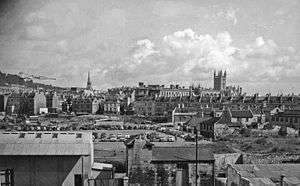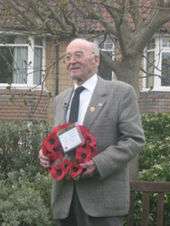Bath Blitz
The term Bath Blitz refers to the air raids by the German Luftwaffe on the British city of Bath, Somerset, during World War II.

The city was bombed in April 1942 as part of the so-called "Baedeker raids", in which targets were chosen for their cultural and historical, rather than their strategic or military, value.
Background
Bath was largely untouched during the Blitz, the German night bombing offensive against Britain's cities, though nearby Bristol was bombed severely throughout that period. Bath was subject to numerous air raid warnings as raiders flew overhead on their way to Bristol, but no bombs were dropped on Bath at this point.
This changed in April 1942 with the start of the Baedeker Blitz, mounted in response to a step-change in the effectiveness of the RAF's bombing offensive in March 1942, that resulted in the destruction of the city of Lübeck.
The Blitz
Over the weekend of 25–27 April 1942, Bath suffered three raids, from 80 Luftwaffe aircraft which took off from Nazi occupied northern France.[1]
As the city sirens wailed, few citizens took cover, even when the first pathfinder flares fell. The people of Bath still believed the attack was destined for nearby Bristol. During the previous four months, Bristol had been hit almost every night, so the people of Bath did not expect the bombs to fall on them.[2]
The first raid struck just before 11 pm on the Saturday night and lasted until 1 am. The German aircraft then returned to France, refuelled, rearmed and returned at 4.35 am. Bath was still on fire from the first raid, making it easier for the German bombers to pick out their targets. The third raid, which only lasted two hours but caused extensive damage, commenced in the early hours of Monday morning. The bombers flew low to drop their high explosives and incendiaries, and then returned to rake the streets with machine-gun fire.[2]
Effects
417 people were killed, another 1,000 injured. Over 19,000 buildings were affected, of which 1,100 were seriously damaged or destroyed, including 218 of architectural or historic interest.[1][2] Houses in the Royal Crescent, Circus and Paragon were destroyed and the Assembly Rooms were burnt out.[1][3] A 500 kilograms (1,100 lb) high explosive bomb landed on the south side of Queen Square, resulting in houses on the south side being damaged.[1] The Francis Hotel lost 24 metres (79 ft) of its hotel frontage, and most of the buildings on Queen Square suffered some level of shrapnel damage. Casualties on the Square were low, considering the devastation, with the majority of hotel guests and staff having taken shelter in the hotel's basement.[1] The majority of Bath's churches were greatly damaged,[4] including St James Church on Stall Street and St Andrew's Church,[5] both of which had to be demolished; the St James site is now a retail building and the St Andrew's site is now a park.
Many buildings have subsequently been restored, or otherwise have been replaced by different buildings or a new land use (such as a park), although there are still some signs of the bombing.[1][6][7]
Legacy

After the raid, an air-raid shelter was provided for Queen Square occupants in the then private central garden. In 1948, the residents gave the garden to the people of Bath with the intention it would become a memorial to the victims of the enemy attacks. Today the square plays host to a variety of community activities, including the Jane Austen Festival and the annual Bath Boules Tournament.[1]
Willi Schludecker, 87, who flew more than 120 sorties for the Luftwaffe, including the Bath Blitz, travelled to the UK as part of Bath's annual remembrance service on Friday 25 April 2008.[8] Willi Schludecker died in a hospital in Cologne on 17 June 2010, at the age of 90.
Among the firefighters assigned to the scene in Bath was Harry Patch, who in the 2000s became the last surviving British Army veteran from the First World War.
In 2016, a live 500 pounds (230 kg) bomb was discovered by workmen under the playground of the former Royal High School, Bath site.[9] The bomb, which had remained undiscovered for over 70 years, was made safe by a bomb disposal team before being removed to the Torr Works quarry and blown up.[10]
References
- Grayling, A. C. (2006); Among the dead cities; Bloomsbury (2006); ISBN 0-7475-7671-8. Pages Pages 50–52
- Harris, Arthur (1947); Bomber Offensive, Pen & Swords, (Paperback 2005), ISBN 1-84415-210-3; page 105
- Spence, Cathryn (2012). Bath in the Blitz: Then and Now. Stroud: The History Press. p. 55. ISBN 9780752466392.
- Warren, Jim. "Bath Blitz Memorial Project". Retrieved 1 July 2012.
- "Royal Crescent History: The Day Bombs fell on Bath". Royal Crescent Society, Bath. Archived from the original on 31 January 2008. Retrieved 9 December 2007.
- "Bath Remembers Devastating 1942 Blitz Bombing". Bath Echo. Retrieved 11 August 2017.
- "Buy St Andrews, Julian Road Prints at Bath in Time". bathintime.co.uk. Archived from the original on 12 August 2017. Retrieved 11 August 2017.
- "Royal Crescent History: The Day Bombs fell on Bath". Royal Crescent Society, Bath. Archived from the original on 31 January 2008. Retrieved 9 December 2007.
- "Concerns over redevelopment plans for listed Bath Blitz bomb damage building". Bath Chronicle. 25 February 2014. Archived from the original on 7 March 2014. Retrieved 26 February 2014.
- "Luftwaffe pilot sorry for bombing". BBC News. 23 April 2008. Retrieved 7 September 2010.
- "Bath WW2 bomb scare: Hundreds of homes evacuated". BBC. Retrieved 15 May 2016.
- "Bath WW2 bomb scare: Device defused, police say". BBC. Retrieved 15 May 2016.
External links
- Bath Blitz website
- BBC News: Blitzed by guidebook Retrieved February 2012
- BBC: People's War Retrieved February 2012